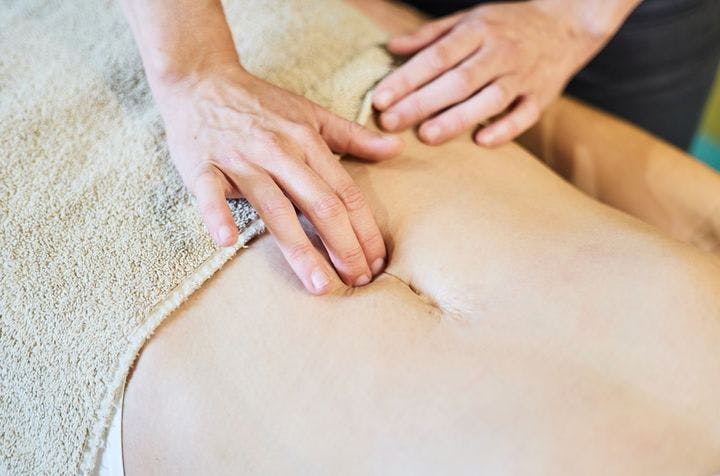Want Healthy Pelvic Floor Muscles? Try These 3 Exercises
Published | 6 min read
Check out these simple exercises and natural supplements that will help you maintain healthy pelvic floor muscles for years to come.

We don’t normally think of strengthening our pelvic floor muscles when we go to the gym. These muscles need just as much exercise and conditioning as any other skeletal muscle in our body. You may have heard of Kegels and other exercises for pelvic floor strength and health. We’ve selected a few of them, all of which do not require equipment and are easy to follow.
Where Are the Pelvic Floor Muscles and Why Are They Important?

The pelvic floor muscles extend from the pubic bones to the tailbone. You can think of them as a stretchy but firm floor that cradles and support your bladder, intestines, and uterus. “Healthy pelvic floor muscles are associated with proper urination and bowel movement, and healthy sexual function”, explains nutritionist Salome Tham.
As we get older, we naturally lose muscle mass, including in our pelvic floor muscles. Conditions or habits that overwork the muscles can also cause them to lose strength or become too tight. These include having multiple births, being overweight or obese, chronic constipation, chronic coughs, and frequently lifting heavy objects. Conditions in old age such as menopausal hormonal changes in women or prostate surgery in men are also possible culprits. Having diabetes may also play a role in weakening pelvic floor muscles.
“In both men and women, weak or overly tight pelvic floor muscles can lead to bowel and urinary incontinence, as well as negatively affect the quality of sexual life due to decreased vaginal sensation in women or erectile dysfunction and premature ejaculation in men”, elaborates Miss Tham.
Exercises for Healthy Pelvic Floor Muscles You Can Do at Home
Miss Tham shares that other than incorporating adequate protein and collagen into your daily diet, the most important thing is to perform simple exercises to strengthen pelvic floor muscles and maintain their elasticity.

1. Start with Kegels
The first place to start would be to do Kegel exercises as these involve muscle awareness. Before doing Kegels, empty your bladder. While doing so, pay attention to the muscles that tighten when you’re holding in your urine, and the release when you urinate. These are your pelvic floor muscles.
“When doing Kegels, practise deep breathing. Pull your diaphragm muscles inward and let the pelvic floor muscles “drop away” from the body. This helps relax the mind and promote qi (life force) circulation. With smooth qi circulation, blood flow is regulated, hence reducing Stagnation, improving symptoms such as pain, menstruation discomfort, and lifting mood”, advises Traditional Chinese Medicine (TCM) Physician Lim Sock Ling.
“When ready and calm, lie on your back, legs out straight, and try to smoothly draw your lower belly muscles in for a count of five, then slowly release. Repeat ten times. This helps to promote intestinal movements and digestion as the action also awakens the organs within,” she suggests.
2. Bridge hip raises with toes up for core strength
The bridge raise is probably the single most featured exercise for pelvic floor strength. It specifically targets your core near your pelvic floor and builds its strength.
To perform the exercise:
- Lie on your back and bend your knees with your feet planted on the floor.
- Lift your toes off the ground while your heels remain.
- Engage the muscles deep in your belly, while at the same contracting your pelvic floor muscles.
- With these muscles engaged, lift your buttocks off the floor while keeping everything stable and strong, keeping your back straight.
- Lower your back down onto the floor and repeat 10 times.
- Try to complete two to four sessions a week.
3. Happy baby yoga pose for a range of motion
The “happy baby” yoga pose is named as such because it mimics a small baby rocking side to side when they’re happy and content. It’s great for massaging the back and building a range of motion in your spine while engaging the pelvic floor muscles.

To perform the exercise:
- Lie on your back and slowly bend your knees towards your armpit. While doing so, reach your hands to hold on to the outside of your feet (left hand on the outside of your left foot, right hand on the outside of your right foot).
- If you can’t reach that far, placing your hands behind your thighs is fine too.
- Engage your abdominal muscles by bringing your belly button closer to your spine. Pull up your pelvic floor muscles as you would while doing Kegels.
- Sway or rock side to side like a happy baby would, increasing your range of motion as you go along.
- Repeat about 10 times, for as long as you feel comfortable.
- Do two sets a day.
Support Pelvic Floor Muscle Health with TCM Herbs and Acupuncture
Supplement your exercise routine with a nutrition-dense diet, including TCM herbs that promote strengthening and ascending of the qi (vital life force), such as Astragalus (huang qi, 黄芪), Codonopsis (dang shen, 党参), and Cimicifuga (sheng ma, 升麻).
Other TCM herbs can complement Kegel exercises to enhance their benefits. In a two-year study published by the National Center for Biotechnology Information of 186 subjects with postpartum pelvic floor dysfunction, the addition of Bu Zhong Yi Qi Tang (补中益气汤) to a treatment regimen of Kegel exercises significantly improved the quality of sexual life for these women.
Herbs that help with strengthening the body include health supplements such as essence of chicken with American ginseng, cordyceps and Chinese yam (shan yao, 山药). However, if you have hypertension, you should be cautious when consuming herbs with uplifting effects such as Bu Zhong Yi Qi Tang, which can cause a rise in blood pressure.
A recent two-year study published in 2020 in the International Journal of Clinical and Experimental Medicine involving 184 patients demonstrated that a TCM “decoction for invigorating qi for ascending” combined with biofeedback electrical stimulation, had great efficacy in the treatment of postpartum pelvic organ prolapse.
Acupuncture can enhance the use of herbal medications and Kegel exercises. A six-week controlled study showed that electroacupuncture administered to the shen shu (BL23, 腎俞), ci liao (BL32, 次髎), zhong liao (BL33, 中髎), and hui yang (BL35, 会阳) points improved urinary incontinence by 54%.
Consult a qualified TCM physician should you encounter any issues with your pelvic floor muscles and want to opt for TCM remedies. This ensures you obtain the appropriate diagnosis and treatment for your body constitution.
There are many exercises that help strengthen pelvic floor muscles, with varying degrees of complexity. Rather than getting too complicated, try focusing on the most basic and important of these exercises to get you started. Combine them with TCM herbs and remedies for a strong and healthy body.
References
- BetterHealth Channel, Department of Health, State Government of Victoria, Australia. Pelvic floor. [Accessed 31 August 2022]
- Cleveland Clinic. 2020. Pelvic Floor Dysfunction. [Accessed 31 August 2022]
- MedLinePlus.gov. 2020. Pelvic floor muscle training exercises. [Accessed 31 August 2022]
- National Association for Continence. Downloadable Pelvic Floor Exercise Sheets. [Accessed 31 August 2022]
- Pelvic Awareness Project. 2022. Good Yoga Exercises to Support Your Core and Pelvic Floor. [Accessed 31 August 2022]
- International Journal of Clinical and Experimental Medicine. 2020. A study of efficacy of traditional Chinese medicine combined with biofeedback electrical stimulation on postpartum pelvic organ prolapse. [Accessed 31 August 2022]
Share this article on










